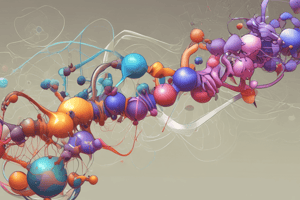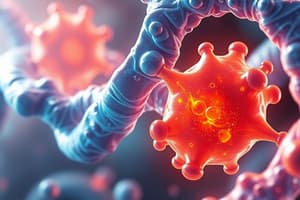Podcast
Questions and Answers
What is the role of enzymes in chemical reactions?
What is the role of enzymes in chemical reactions?
- Enzymes act as inhibitors of chemical reactions.
- Enzymes act as biological catalysts, increasing reaction rates by lowering activation barriers. (correct)
- Enzymes act as reactants in chemical reactions.
- Enzymes act as energy sources for chemical reactions.
What happens in the absence of enzyme catalysis in chemical reactions?
What happens in the absence of enzyme catalysis in chemical reactions?
- Chemical reactions occur without any impact on life sustenance.
- Chemical reactions occur at a slower rate.
- Chemical reactions could not occur on a useful time scale, hindering the sustenance of life. (correct)
- Chemical reactions occur at a faster rate.
What is the consequence of excessive activity of an enzyme?
What is the consequence of excessive activity of an enzyme?
- It can lead to disease. (correct)
- It enhances overall health.
- It has no impact on health.
- It leads to increased enzyme specificity.
Why are measurements of enzyme activities in blood plasma, erythrocytes, or tissue samples important?
Why are measurements of enzyme activities in blood plasma, erythrocytes, or tissue samples important?
What is a key characteristic of enzyme catalysis?
What is a key characteristic of enzyme catalysis?
Which statement best describes the transition state in a reaction?
Which statement best describes the transition state in a reaction?
What is the relationship between equilibrium constant (K′eq) and standard free-energy change (∆G′°)?
What is the relationship between equilibrium constant (K′eq) and standard free-energy change (∆G′°)?
What does the activation energy (∆G‡) represent in a reaction?
What does the activation energy (∆G‡) represent in a reaction?
How do catalysts affect reaction rates and equilibria?
How do catalysts affect reaction rates and equilibria?
What is the role of the enzyme-substrate complex in enzyme-catalyzed reactions?
What is the role of the enzyme-substrate complex in enzyme-catalyzed reactions?
Which mechanism by which the enzyme itself undergoes a conformational change when the substrate binds, induced by multiple weak interactions with the substrate?
Which mechanism by which the enzyme itself undergoes a conformational change when the substrate binds, induced by multiple weak interactions with the substrate?
What is the measure of the affinity an enzyme has for its substrate, as the lower the value of Km, the more efficient the enzyme is at carrying out its function at a lower substrate concentration?
What is the measure of the affinity an enzyme has for its substrate, as the lower the value of Km, the more efficient the enzyme is at carrying out its function at a lower substrate concentration?
What type of catalysis occurs when a transient covalent bond forms between the enzyme and the substrate?
What type of catalysis occurs when a transient covalent bond forms between the enzyme and the substrate?
What serves to bring specific functional groups on the enzyme into the proper position to catalyze the reaction?
What serves to bring specific functional groups on the enzyme into the proper position to catalyze the reaction?
What is the discipline focused on determining the rate of a reaction and how it changes in response to changes in experimental parameters?
What is the discipline focused on determining the rate of a reaction and how it changes in response to changes in experimental parameters?
What is the Michaelis-Menten equation for a one-substrate enzyme-catalyzed reaction?
What is the Michaelis-Menten equation for a one-substrate enzyme-catalyzed reaction?
What does a Lineweaver-Burk plot reveal for competitive inhibition?
What does a Lineweaver-Burk plot reveal for competitive inhibition?
What happens to the apparent Km in the presence of an uncompetitive inhibitor?
What happens to the apparent Km in the presence of an uncompetitive inhibitor?
What is the relationship between V0, Vmax, [S], and Km in the Michaelis-Menten equation?
What is the relationship between V0, Vmax, [S], and Km in the Michaelis-Menten equation?
What is the equation for the dissociation constant, Kd, for reactions with two steps?
What is the equation for the dissociation constant, Kd, for reactions with two steps?
What is the rate equation for a second-order reaction involving compounds S and T?
What is the rate equation for a second-order reaction involving compounds S and T?
What type of interactions mediate the interactions between enzymes and substrates?
What type of interactions mediate the interactions between enzymes and substrates?
What is the range in which enzymes enhance rates of reactions?
What is the range in which enzymes enhance rates of reactions?
What type of interactions between enzyme and substrate lower the activation energy?
What type of interactions between enzyme and substrate lower the activation energy?
What overcomes barriers to reaction such as the entropy of molecules in solution and substrate distortion?
What overcomes barriers to reaction such as the entropy of molecules in solution and substrate distortion?
What serves as transient carriers of specific atoms or functional groups in enzymatic reactions?
What serves as transient carriers of specific atoms or functional groups in enzymatic reactions?
What are enzymes classified into based on the type of reaction they catalyze?
What are enzymes classified into based on the type of reaction they catalyze?
What is the primary factor on which the catalytic activity of enzymes depends?
What is the primary factor on which the catalytic activity of enzymes depends?
What was the name given to the molecules detected in cell-free yeast extracts that could ferment sugar to alcohol?
What was the name given to the molecules detected in cell-free yeast extracts that could ferment sugar to alcohol?
What do enzyme active sites use to lower the activation barrier of catalyzed reactions?
What do enzyme active sites use to lower the activation barrier of catalyzed reactions?
What is the rate equation for a first-order reaction?
What is the rate equation for a first-order reaction?
What type of interactions between enzyme and substrate lower the activation energy?
What type of interactions between enzyme and substrate lower the activation energy?
What is the relationship between rate constant k and activation energy ∆G‡?
What is the relationship between rate constant k and activation energy ∆G‡?
What do enzymes enhance rates in the range of?
What do enzymes enhance rates in the range of?
What type of reaction depends on the concentration of two different compounds?
What type of reaction depends on the concentration of two different compounds?
What is the primary factor on which the catalytic activity of enzymes depends?
What is the primary factor on which the catalytic activity of enzymes depends?
What serves as transient carriers of specific atoms or functional groups in enzymatic reactions?
What serves as transient carriers of specific atoms or functional groups in enzymatic reactions?
What are enzymes classified into based on the type of reaction they catalyze?
What are enzymes classified into based on the type of reaction they catalyze?
What do enzyme active sites use to lower the activation barrier of catalyzed reactions?
What do enzyme active sites use to lower the activation barrier of catalyzed reactions?
What is the measure of the affinity an enzyme has for its substrate, as the lower the value of $K_m$, the more efficient the enzyme is at carrying out its function at a lower substrate concentration?
What is the measure of the affinity an enzyme has for its substrate, as the lower the value of $K_m$, the more efficient the enzyme is at carrying out its function at a lower substrate concentration?
What is the consequence of excessive activity of an enzyme?
What is the consequence of excessive activity of an enzyme?
What serves as practical tools in chemical engineering, food technology, and agriculture?
What serves as practical tools in chemical engineering, food technology, and agriculture?
What is the primary factor on which the catalytic activity of enzymes depends?
What is the primary factor on which the catalytic activity of enzymes depends?
What is the role of enzymes in chemical reactions?
What is the role of enzymes in chemical reactions?
What are the fundamental conditions for life according to the text?
What are the fundamental conditions for life according to the text?
What is the relationship between the transition state and the ground state in a reaction?
What is the relationship between the transition state and the ground state in a reaction?
What is the activation energy (∆G‡) in a reaction?
What is the activation energy (∆G‡) in a reaction?
What do catalysts do to affect reaction rates and equilibria?
What do catalysts do to affect reaction rates and equilibria?
What is the relationship between equilibrium constant (K′eq) and standard free-energy change (∆G′°)?
What is the relationship between equilibrium constant (K′eq) and standard free-energy change (∆G′°)?
What is the biochemical standard free-energy change, ∆G′°, at pH 7.0?
What is the biochemical standard free-energy change, ∆G′°, at pH 7.0?
What is the Michaelis constant, Km, a measure of?
What is the Michaelis constant, Km, a measure of?
What is the primary function of induced fit in enzyme catalysis?
What is the primary function of induced fit in enzyme catalysis?
What type of catalysis occurs when a transient covalent bond forms between the enzyme and the substrate?
What type of catalysis occurs when a transient covalent bond forms between the enzyme and the substrate?
What does the maximum rate of the reaction, Vmax, represent?
What does the maximum rate of the reaction, Vmax, represent?
What is the role of metal ions in enzyme catalysis?
What is the role of metal ions in enzyme catalysis?
What is the relationship between substrate concentration and initial reaction rate, as expressed by the Michaelis-Menten equation?
What is the relationship between substrate concentration and initial reaction rate, as expressed by the Michaelis-Menten equation?
What type of plot yields a straight line for enzymes obeying the Michaelis-Menten relationship?
What type of plot yields a straight line for enzymes obeying the Michaelis-Menten relationship?
What happens to the apparent $K_m$ in the presence of an uncompetitive inhibitor?
What happens to the apparent $K_m$ in the presence of an uncompetitive inhibitor?
What is the equation for the Lineweaver-Burk plot?
What is the equation for the Lineweaver-Burk plot?
What does a Lineweaver-Burk plot reveal for competitive inhibition?
What does a Lineweaver-Burk plot reveal for competitive inhibition?
Study Notes
Enzymes: Key Principles and Characteristics
- Enzymatic reactions occur in specialized pockets called active sites where the conversion of a substrate to a product takes place.
- Enzymes bind most tightly to the transition state of the catalyzed reaction, using binding energy to lower the activation barrier.
- Enzyme active sites are organized by evolution to facilitate multiple mechanisms of chemical catalysis simultaneously.
- Many enzymes are regulated through reversible covalent modification, binding of allosteric modulators, proteolytic activation, noncovalent binding to regulatory proteins, and elaborate regulatory cascades.
- Biological catalysis was first recognized in the late 1700s, and the name "enzymes" was given to the molecules detected in cell-free yeast extracts that could ferment sugar to alcohol.
- Most enzymes are proteins, and their catalytic activity depends on the integrity of the native protein conformation.
- Enzymes have a wide range of molecular weights, from 12,000 to over 1 million, and may require additional chemical components such as cofactors and coenzymes.
- Inorganic ions such as Cu2+, Fe2+/Fe3+, K+, Mg2+, Mn2+, Mo, Ni2+, and Zn2+ serve as cofactors for various enzymes.
- Coenzymes such as biotin, coenzyme A, flavin adenine dinucleotide, lipoate, and others serve as transient carriers of specific atoms or functional groups.
- Enzymes may contain prosthetic groups, and the complete catalytically active enzyme together with its bound coenzyme and/or metal ions is known as a holoenzyme.
- Enzymes are classified into seven classes based on the type of reaction catalyzed, each with subclasses, and most enzymes have trivial names in addition to their systematic and enzyme commission numbers.
- Each enzyme has a four-part enzyme commission number (E.C. Number) and a systematic name that classifies them based on the type of reaction they catalyze.
Enzymes: Key Principles and Characteristics
- Enzymatic reactions occur in specialized pockets called active sites where the conversion of a substrate to a product takes place.
- Enzymes bind most tightly to the transition state of the catalyzed reaction, using binding energy to lower the activation barrier.
- Enzyme active sites are organized by evolution to facilitate multiple mechanisms of chemical catalysis simultaneously.
- Many enzymes are regulated through reversible covalent modification, binding of allosteric modulators, proteolytic activation, noncovalent binding to regulatory proteins, and elaborate regulatory cascades.
- Biological catalysis was first recognized in the late 1700s, and the name "enzymes" was given to the molecules detected in cell-free yeast extracts that could ferment sugar to alcohol.
- Most enzymes are proteins, and their catalytic activity depends on the integrity of the native protein conformation.
- Enzymes have a wide range of molecular weights, from 12,000 to over 1 million, and may require additional chemical components such as cofactors and coenzymes.
- Inorganic ions such as Cu2+, Fe2+/Fe3+, K+, Mg2+, Mn2+, Mo, Ni2+, and Zn2+ serve as cofactors for various enzymes.
- Coenzymes such as biotin, coenzyme A, flavin adenine dinucleotide, lipoate, and others serve as transient carriers of specific atoms or functional groups.
- Enzymes may contain prosthetic groups, and the complete catalytically active enzyme together with its bound coenzyme and/or metal ions is known as a holoenzyme.
- Enzymes are classified into seven classes based on the type of reaction catalyzed, each with subclasses, and most enzymes have trivial names in addition to their systematic and enzyme commission numbers.
- Each enzyme has a four-part enzyme commission number (E.C. Number) and a systematic name that classifies them based on the type of reaction they catalyze.
Studying That Suits You
Use AI to generate personalized quizzes and flashcards to suit your learning preferences.
Related Documents
Description
Test your knowledge of enzymes with this quiz on the key principles and characteristics of enzymatic reactions. Explore topics such as enzyme classification, active sites, cofactors, coenzymes, and regulatory mechanisms. Brush up on your understanding of biological catalysis and learn about the diverse range of enzymes and their molecular weights.




